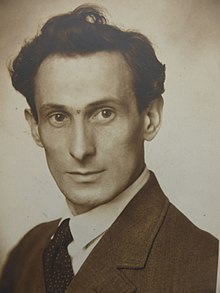Georg Rauchberger
Georg Rauch Berger (* 31 March 1895 in Lenggries , † the 30th October 1973 in Regensburg ) was an art painter and district home pfleger for the Upper Palatinate .
Life
His father came from South Tyrol and was a master belt maker who made church implements in neo-Gothic style. He was also a hobby painter and became known for his battle paintings. Painting also became a hobby of Georg Rauchberger. He began his career as a construction intern at the Reichsbahn, took part in the First World War and was a shipping officer at the Danube shipping company Bayerischer Lloyd until 1945. After the Second World War he became a clerk in the government of the Upper Palatinate and Lower Bavaria, and since 1950 he has been the local nurse of the Upper Palatinate. He was married to his wife Mathilde.
Wolfsegg Castle
The acquisition and maintenance of Wolfsegg Castle, which has now become a half-ruin, is one of Rauchberger's merits . On January 26, 1933, after lengthy negotiations, he was able to acquire the building, which was not loved by the Wolfsegg community, for 2300 Reichsmarks and, with great personal commitment, protect it from further deterioration.
To safeguard his legacy, Rauchberger founded the Kuratorium Burg Wolfsegg eV on September 5, 1970 under the motto “Fortuna ac Fortudine” (“With luck and steadfastness”). V. ”for further maintenance of the castle. After Rauchberger's death, the castle passed into the hands of this board of trustees after a number of inheritance disputes and is still owned by them today. As for the fabulous white woman in the castle, he said: "Well, I haven't seen her yet, I just have a picture of her hanging."
Many of his paintings and sketches are kept and exhibited in Wolfsegg Castle.
Kreuzhof Chapel
Smokingberger was also able to buy the Kreuzhofkapelle zu Barbing from the Thurn und Taxis family in April 1948 and use private funds to save it from deterioration. The chapel and the surrounding cemetery were originally intended as a settlement area for received to Bavaria expellees be used. The chapel is of great historical importance: In this chapel in 1156 Emperor Friedrich Barbarossa negotiated the “ Privilegium minus ” and thus the separation of the “Mark Ostarrîchi”, the core cell of Austria, from the Duchy of Bavaria and its transfer to Heinrich Jasomirgott from Babenberg . The chapel was already under the Staufer King Konrad III in 1147 . the assembly point for the so-called Second Crusade and again in 1189 under Emperor Friedrich Barbarossa assembly point for the Third Crusade , in which Barbarossa drowned in the Saleph River. In 1960, the chapel was again seriously endangered by a planned expansion of the east port of Regensburg; Rauchberger managed to move the harbor entrance a few hundred meters further upstream.
In 1950 he transferred the right to unrestricted use of the chapel for worship services to the Regensburg Bishop's Office . In 1953 he decreed in his will that the Kreuzhof Chapel should be handed over to the Episcopal See in Regensburg after the death of him and his wife. Georg Rauchberger found his final resting place with his wife in a crypt in this chapel.
Honors
In 1972 Georg Rauchberger was made an honorary citizen of the Wolfsegg community for his services to the preservation of Wolfsegg Castle; As the Mittelbayerische Zeitung wrote, the " White Woman " did not show up during the ceremony of the awarding of the certificate of honor in the flickering candlelight in the knight's hall of the castle, to the regret of those present.
literature
- Neumeyer, Hermann (1978). The last lord of Wolfsegg: Georg Rauchberger. Memory of a lovely colleague and active monument conservator. The Upper Palatinate, Volume 66, pp. 144–147.
- Appl, Tobias (2007). Kreuzhof and Kreuzhof Chapel. Negotiations of the Historical Association for the Upper Palatinate and Regensburg, Volume 147 , pp. 29–47.
- Familiar with castles, churches and ghosts. The home nurse of the Upper Palatinate: Georg Rauchberger. Mittelbayerische Zeitung, 16./17. January 1965.
Individual evidence
- ↑ Birgit Angerer (1987). Museum concept and texts for Wolfsegg Castle. Manuscript containing Georg Rauchnberger 18951973. Savior of Wolfsegg Castle.
| personal data | |
|---|---|
| SURNAME | Rauchberger, Georg |
| BRIEF DESCRIPTION | Local history explorer |
| DATE OF BIRTH | March 31, 1895 |
| PLACE OF BIRTH | Lenggries |
| DATE OF DEATH | October 30, 1973 |
| Place of death | regensburg |

